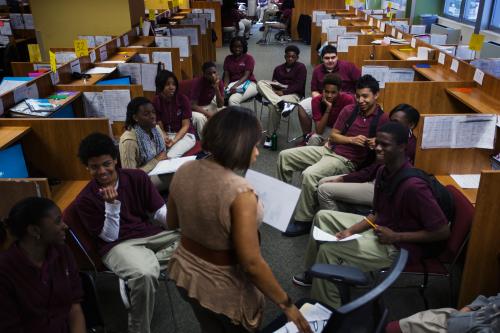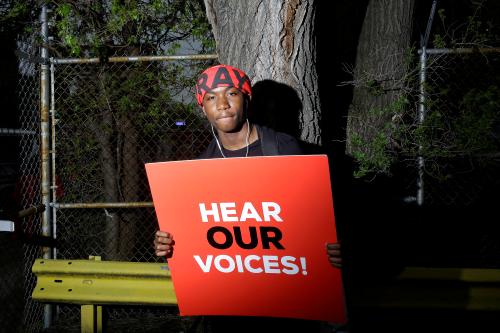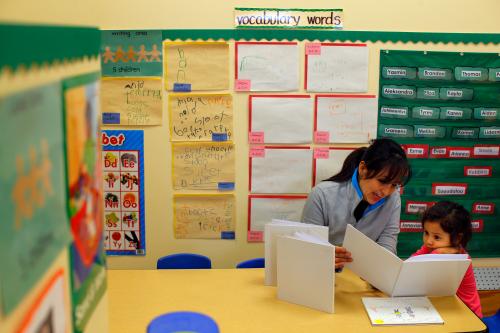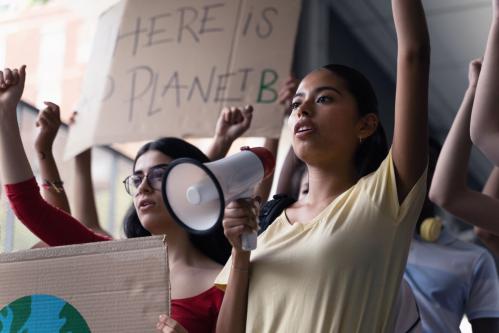In my time at the Education Trust, a large chunk of my work has revolved around how we recruit and retain more teachers of color. And as Black History Month comes to a close, I’ve reflected on the status of black teachers specifically and their experiences in the school building. We know the data: All students benefit from having teachers of color in their classroom, and that’s especially true for students of color.
The story of my own educational journey provides a confirmatory anecdote for the findings presented in the literature. As a black male with a mother who also worked in public schools, my educational path was curated to where I had black teachers at numerous points along my elementary and secondary path, and as such, I felt safe, respected, and felt like I belonged. I flourished.
Though analysts and practitioners have talked a lot about the type of environment students of color need in school to be successful, I worry that we may overlook teachers of color and their similar need for a strong and supportive school climate to thrive as well. Two of the main factors that cause teachers of color to leave the field are poor working conditions and lack of autonomy.
Moreover, the voices of black teachers help us see that they are subjected to similar systems of racism that black students face in the classroom every day. Where black students experience disproportionate discipline, unequal opportunities to participate in advanced coursework, and more negative perceptions of school climate, black teachers often report feeling invisible, being passed over for advancement opportunities, and feeling the need to prove their worth to their students, parents, and colleagues. Indeed, black teacher experiences, and many teacher of color experiences, are school climate issues.
These present day climate issues reach back across nearly 65 years for black teachers. The loss of 38,000 black teachers and leaders during the integration of schools following the Brown v. Board of Education decision speaks volumes about how public schools approach the issue of integration: with students—not teachers—as the primary focus. I submit that these same school climate issues that teachers of color experience today also plagued the black teachers and leaders entering integrated settings over 50 years ago.
Moreover, the problem is that though we integrated schools by placing bodies together in buildings, we haven’t yet completed the necessary work to create spaces where both black teachers and black students feel like they are safe, respected, and encouraged to be their authentic selves. As a strong school climate is important to the outcomes for students, it’s just as important for teachers to have that as well. Both then and now, it’s an untenable situation for a school to be set up in a way that denies black teachers and students the physical, social, and emotional security they deserve.
All is not lost, though. If we shift our perspective from integrating bodies to realizing what diversity truly means, we can change the experiences for black students, black teachers, and countless others whose voices easily go unnoticed. As we are finding ways to bring people together, we also have to create space for the integration of everyone’s thoughts, cultures, beliefs, and values.
Change is already happening
In some of our forthcoming research, Education Trust partnered with Teach Plus to examine schools and districts being intentional about retaining teachers of color. We conducted focus groups across the country with teachers of color to understand what their perspectives are on how to create an environment where they are more likely to stay in the field. We also went on the road to conduct case studies in schools and district programs to see how leaders are actually doing the work to retain their teachers of color. Where leaders are committed to teacher of color retention, we saw school climates where teachers of color feel like they belong. In these schools, the teachers:
- Are engulfed in an environment that aligns with their values. They have the space to build students academically, but more importantly, they develop their students’ ability to be change agents in the community around the school with a commitment to equity and social justice.
- Build strong interpersonal connections between all levels in the school that promote the feeling of a big family. They also have administrators who are responsive, transparent, and strong communicators, which fosters trust.
- Are encouraged to be their authentic selves. This means that teachers have the freedom to be themselves both as an individual and as a person of color (if applicable). In our conversations, we heard references of teachers feeling like they can be “unapologetically black,” “woke,” or free to express their racial identity in a variety of ways.
- Are empowered to advocate for their students, take initiative wherever they see a need in the school, and use their own discretion in how the teach their classes (materials, projects, course content). They also feel supported through their access to professional development opportunities and meetings that broach tough conversations about sometimes controversial subjects.
Ultimately, teachers of color must be respected as professionals—and more importantly as people.
If we really want to diversify the workforce, the attention we pay to school climate can’t just be for the students. The school climate in which we recruit and retain these teachers of color has to be strong and positive as well. In this increasingly diverse society, our country’s history has shown us what happens when we don’t carefully bring people together. Today, we have the opportunity to do better. Let’s move forward.
The Brookings Institution is committed to quality, independence, and impact.
We are supported by a diverse array of funders. In line with our values and policies, each Brookings publication represents the sole views of its author(s).








